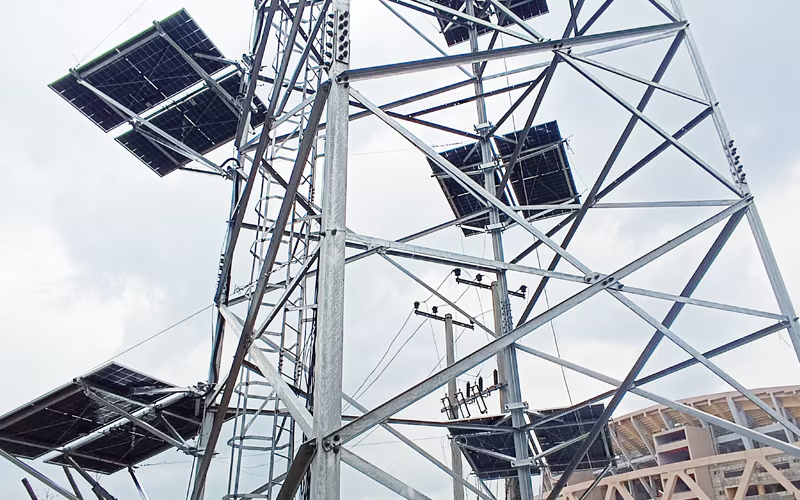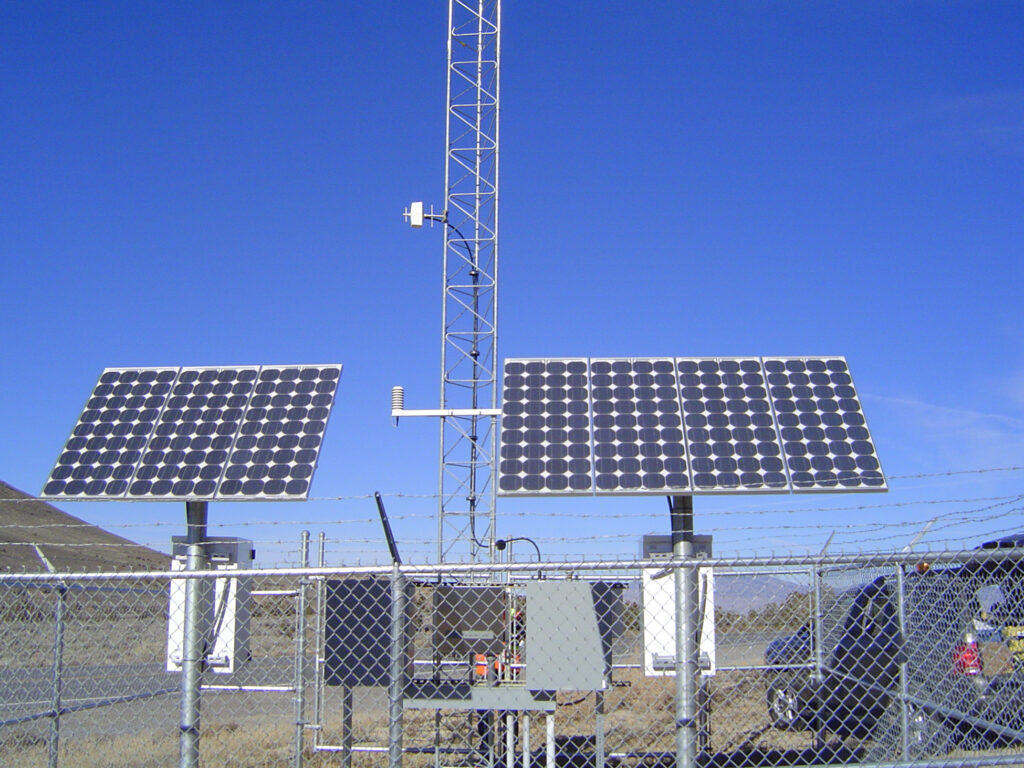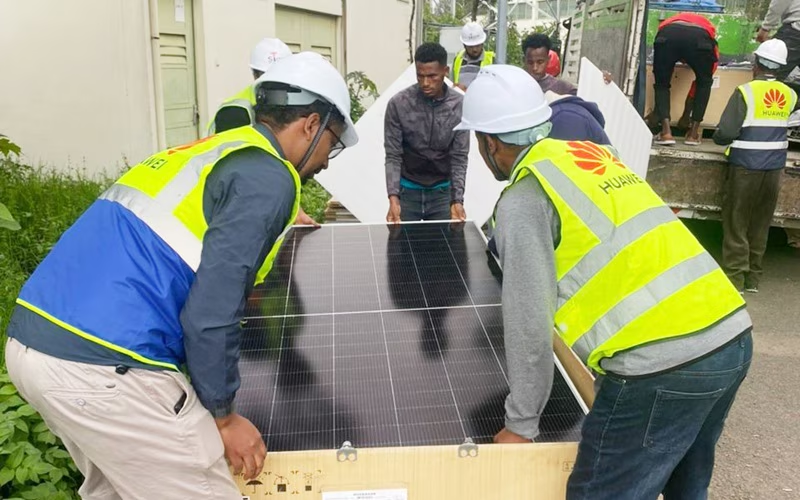On 25 August 2025, a quiet but powerful revolution began in Ethiopia that could reshape Africa’s telecommunications industry for decades. Ethio Telecom, one of the continent’s largest and oldest mobile operators, joined hands with Huawei to launch Africa’s first-ever Solar-on-Tower sites.
The idea is deceptively simple but immensely transformative: instead of covering scarce land with solar panels, why not mount them directly onto telecom towers themselves? It’s a bold solution to a longstanding problem in African cities where space is limited, power supply is unreliable, and diesel generators have become a costly lifeline.
In Addis Ababa—the pilot site—the results have been immediate and encouraging. The solar-on-tower installation went commercial smoothly and started producing clean energy within just two days. More importantly, each site has already reduced its diesel use by 40%, cutting down generator runtime from six hours to just two per day.
This marks more than just a technical upgrade. It signals the arrival of a new era for African telecommunications—an era where connectivity doesn’t have to come at the expense of the environment.

Table of Contents
Solar Meets Telecom: A Clever Innovation in Urban Africa
Across Africa, mobile operators face the same challenge: how to expand network coverage while also reducing costs and emissions. The dilemma is particularly acute in cities like Addis Ababa, Lagos, Nairobi, and Johannesburg, where dense populations mean massive demand for connectivity but little room to expand energy infrastructure.
Traditionally, telecom towers in urban centres depend heavily on diesel generators. Diesel is expensive, polluting, and vulnerable to global price swings. For an operator like Ethio Telecom, which serves over 70 million subscribers, the cost of running thousands of towers on diesel quickly becomes a financial burden.
The Solar-on-Tower concept flips this problem on its head. Instead of requiring vast tracts of land for solar farms, the towers themselves become part of the solution. Panels are installed directly onto the vertical structures, capturing sunlight throughout the day. The energy is then fed into the site, reducing reliance on diesel and the unreliable local grid.
The benefits are immediate and measurable:
- Extra 4 hours of solar operation daily, extending uptime without diesel.
- 40% reduction in diesel use, saving thousands of litres per site annually.
- Lower carbon emissions, aligning with Ethiopia’s climate commitments.
- Faster deployment, with sites up and running in just two days.
This is not just about efficiency. It’s also about resilience. By tapping into solar, Ethio Telecom and Huawei are ensuring that networks remain operational even during fuel shortages or power cuts—a frequent issue in many African countries.
One Huawei engineer at the launch was quoted as saying: “We turned a tower into more than just a tower—it’s now a mini power station.” That simple framing captures the scale of what’s unfolding: telecom infrastructure doubling as renewable energy infrastructure.

Setting a Green Benchmark for Africa’s Telecom Future
Ethiopia’s move is not happening in isolation. Across the continent, governments and businesses are racing to align with Africa’s green energy transition. From South Africa’s push for rooftop solar to Nigeria’s mini-grid revolution, the message is clear: renewable energy is no longer optional; it is essential.
Yet telecom companies have often lagged behind in this transition. Network expansion has traditionally meant more diesel, more emissions, and higher costs passed on to consumers. The Ethio Telecom–Huawei partnership now offers a fresh blueprint.
By adopting Solar-on-Tower, operators can sidestep the land constraints that have often limited solar adoption in cities. Addis Ababa’s pilot project shows that even in the heart of a capital city, where every square metre of land is contested, renewable energy can find a place—on the towers that already dot the skyline.
For Africa, this could be a game-changer. According to GSMA (the global mobile operators’ association), Africa will need to add 100,000 new telecom towers by 2030 to meet growing connectivity demands. If even a fraction of these towers adopt solar-on-tower technology, the savings in fuel costs and emissions could be enormous.
Let’s put this in perspective:
| Metric | Current Diesel Use (Typical Tower) | With Solar-on-Tower | Reduction |
|---|---|---|---|
| Daily Diesel Hours | 6 hours | 2 hours | –4 hours |
| Fuel Consumption | 20 litres/day | 12 litres/day | –40% |
| Annual CO₂ Emissions | 25 tonnes | 15 tonnes | –10 tonnes |
Multiply this by thousands of towers, and the potential becomes staggering. This isn’t just Ethiopia’s win; it could be a continental milestone.
A Shared Vision: Green Networks, Resilient Communities
At the launch event, Ethio Telecom’s leadership framed the project not only as a business investment but also as part of a moral responsibility. As Ethiopia battles both urban air pollution and the broader effects of climate change, moving away from diesel is more than a cost-saving measure—it is a necessity for public health and national resilience.
Huawei, for its part, has been positioning itself as a global leader in green ICT solutions. The company has invested heavily in renewable energy integration for telecom infrastructure, from solar base stations in Asia to energy-efficient 5G sites in Europe. The Addis Ababa project is its first full-scale demonstration of Solar-on-Tower in Africa, and Huawei executives have made clear they see the continent as a key testing ground for scalable green technologies.
A senior Ethio Telecom engineer shared her reflections with local media: “When I joined the company ten years ago, diesel was our only option. Today, I see towers running on the sun. For me, this is not just technology—it’s hope.”
Her words capture something crucial: while this project is about towers and panels, it is also about people. Every litre of diesel saved means fewer toxic fumes in urban neighbourhoods. Every hour of extra solar uptime means more reliable internet for small businesses, students, and families.
For Nigeria, Kenya, Ghana, and beyond, the lesson is obvious: innovation doesn’t have to wait for perfect conditions. By rethinking how we use existing infrastructure, countries can leapfrog old models and move directly into a cleaner future.
What This Means for Africa
As a Nigerian writing about this story, I find it particularly powerful. We live in a country where the hum of diesel generators is part of the national soundtrack. We know the cost—financially, environmentally, and even emotionally—of depending on fuel that is both dirty and unreliable.
Ethiopia’s success challenges us to ask: why not here? If Addis Ababa can power its towers with solar panels mounted vertically, then Lagos or Abuja surely can too. Our skies are just as bright, our towers just as tall, and our need for sustainable solutions just as urgent.
The Ethio Telecom–Huawei partnership is more than a business arrangement; it is a vision for Africa’s future. One where digital connectivity is not powered by smoke and fumes, but by sunlight and ingenuity. One where innovation solves problems instead of creating new ones.
And perhaps most importantly, it is a reminder that progress often comes from collaboration—between governments, local companies, and global partners. Africa’s energy transition won’t happen by chance; it will happen when partnerships like this are scaled, supported, and adapted across borders.

Conclusion: Towers of Change
The launch of Africa’s first Solar-on-Tower sites is both symbolic and practical. Symbolic, because it shows that Africa can lead in designing solutions tailored to its own realities. Practical, because it delivers measurable cost savings, reduced emissions, and stronger network resilience.
As Ethio Telecom and Huawei commit to expanding this model, the message is clear: Africa’s telecom future can be both digital and sustainable. The challenge now is for other operators—and indeed governments—to take the cue.
In the end, the humble telecom tower, once just a steel structure carrying antennas, may now stand as a beacon of Africa’s green future—a future powered not by diesel, but by the sun.
Join Our Social Media Channels:
WhatsApp: NaijaEyes
Facebook: NaijaEyes
Twitter: NaijaEyes
Instagram: NaijaEyes
TikTok: NaijaEyes













![Tragic Incident: Fans of Seyi Vibez Die in Fatal Accident After Electrifying Lagos Concert [VIDEO] Seyi Vibez](https://naijaeyesblog.com/wp-content/uploads/2025/08/Seyi-Vibez-180x135.avif)


























